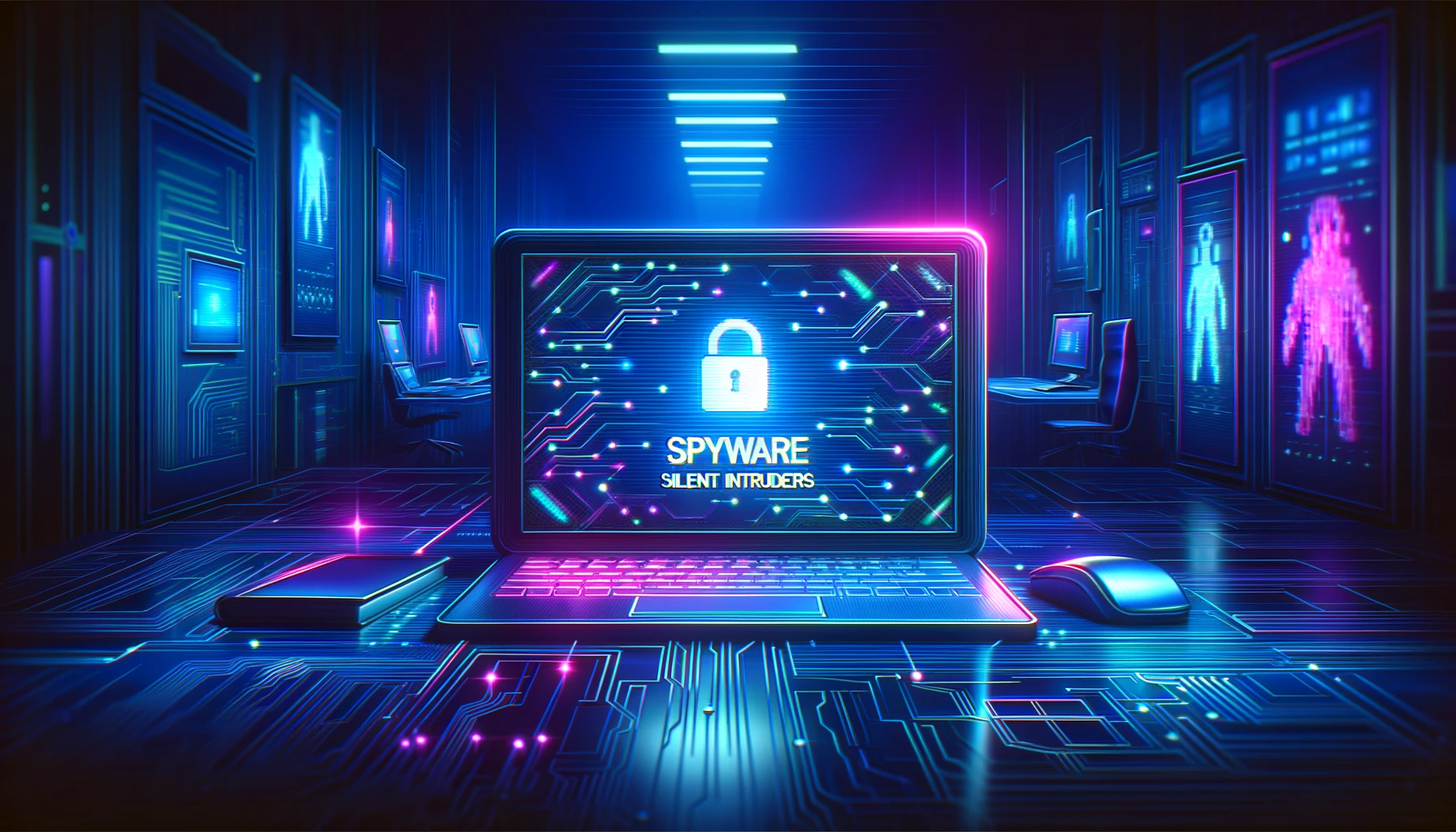Spyware: Silent Intruders and Mitigation Techniques

The word spyware is a portmanteau of spying and malware. In essence, spyware is a malicious program designed to collect various sensitive information from a user’s device. This data may be login credentials, personal data, or other information that an attacker can use to plan and carry out their attacks.
Data is a valuable commodity. Access to an online account typically fetches a few dollars on the Dark Web, while a single medical record is worth up to $1,000 to a cybercriminal. Intellectual property, such as trade secrets or blueprints for restricted or advanced technology, can fetch far more.
As a result, spyware is a growing risk to individuals and businesses alike. This article explores the spyware threat, including the malware’s capabilities, leading spyware campaigns, and best practices for preventing, detecting, and remediating spyware infections.
What is Spyware?
Spyware is malware focused on collecting personal data from an infected system. Spyware can collect a wide range of data, including login credentials, personally identifiable information (PII), intellectual property (IP), and online browsing habits.
This information can be used for various malicious purposes. Common use cases include identity theft, financial fraud, and corporate espionage.
Spyware can gain access to a computer in various ways. Some common spyware infection mechanisms include:
Phishing: Phishing uses social engineering to convince a user to open an attachment or a malicious link. The focus is on targeting the human element, rather than exploiting vulnerabilities in software or other security processes.
Bundled Programs: Freeware and shareware are free programs, files, and tools that are available for download for free from the Internet. Often, these programs come in bundles where less desirable programs are included alongside a more desirable one. In some cases, these bundles may include spyware and other types of malware.
Vulnerability Exploitation: Some spyware gains access to a device by exploiting vulnerabilities. This is especially true of mobile spyware, which may incorporate zero-click infection mechanisms.
Once installed on a device, spyware can collect sensitive information in various ways. Some common mechanisms include:
- Keylogging: Capturing keystrokes entered into a computer allows spyware to steal credentials, payment card information, and other sensitive data.
- Screenshots: Screenshots can provide valuable information by allowing the attacker to see sensitive data displayed on the user’s screen as they access online accounts.
- Online Tracking: Spyware commonly collects information about a user’s online activities such as browser history, cookies, and other information.
- File Access: Spyware also has access to the file system and may be able to scan through saved documents to identify useful information for exfiltration.
- Device-Specific Data: Spyware may also be designed to collect information tailored to the type of device that is infected. For example, mobile spyware may collect geolocation data using the device’s built-in GPS.
After the spyware has collected sensitive information, it sends it to the attacker. Malware commonly has command and control (C2) infrastructure in place that allows it to send data to the attacker and receive instructions in response. C2 communications are typically designed to hide within normal network traffic, embedding data in commonly-used network protocols.
The Risks of Spyware
The goal of spyware is to collect and exfiltrate sensitive data to an attacker. Spyware infection can have various potential impacts, such as:
Data Theft: Data breaches are the primary purpose of spyware. Information such as login credentials or users’ PII can be sold on the black market or used in later attacks. For example, spyware can collect a range of sensitive details that an attacker can use to make a spear phishing attack look much more convincing.
Account Takeover: Spyware can steal login credentials, including passwords or one-time passwords (OTPs) used for multi-factor authentication. This could allow the attacker to gain access to a user’s other online accounts.
Identity Theft: Users may have sensitive personal information saved in documents on their computers, such as government ID numbers and other data used to validate a user’s identity. With this information, an attacker may be able to impersonate the user and open up accounts in their name.
Financial Fraud: Financial data is another form of sensitive information that might be stored on a computer and collected by spyware. With bank account numbers and credentials, an attacker can steal money from an organization or a business.
Recent Examples of Spyware Attacks
Spyware is one of the most common types of malware. Some examples of major spyware campaigns performed in recent years include:
Pegasus:Pegasus is likely the most famous spyware variant and is an example of mobile malware targeting both iOS and Android devices. The malware — developed by the Israeli NSO Group — is available to governments and commonly used to spy on dissidents, activists, journalists, and government officials. Pegasus is known for its zero-click exploits, which allow it to gain access to a mobile device by exploiting vulnerabilities without the need for user interaction.
Google TAG Research: In March 2023, Google’s Threat Analysis Group (TAG) unveiled two different active spyware campaigns performed by “commercial spyware vendors”, who sell spyware to governments and other state-sponsored actors. One campaign used bit.ly links in SMS messages to take users to sites hosting exploits for their device, while the other took advantage of vulnerabilities in Samsung Internet Browser to deliver the malware.
DarkHotel: DarkHotel is a spyware variant that has existed since 2014 and targets business travelers. Travelers using public, insecure hotel wireless networks are targeted by the malware, which installs a keylogger on their device. This keylogger can then be used to collect login credentials and other sensitive information.
Spyware can be used for various purposes, and these goals determine the geographic regions and industries that a particular campaign might target. For example, Pegasus is commonly used against political targets, while spyware for corporate espionage might target high-level executives in a particular industry.
Spyware Use Cases and Statistics

Spyware Prevention and Future Trends
Spyware is stealthy, dangerous malware. Once infected, it can be difficult to detect and remediate, so the best approach to managing the spyware threat is prevention. Some best practices for reducing the risk of spyware infections include:
- Anti-Malware and Anti-Spyware: Spyware is a type of malware and should be detectable by anti-virus, anti-malware, and anti-spyware software. Installing a reputable antivirus, keeping it up to date, and running regular scans can help to detect and block spyware from gaining access to a computer and to eradicate existing infections.
- User Education: Phishing attacks and malicious downloads are two common infection vectors for spyware. Educating users to identify the signs of these attacks and respond appropriately can help to reduce the risk of infection.
- Patch Management: Another common infection vector for spyware is exploiting unpatched software. Promptly applying software updates and patches can help to close the security gaps created by these vulnerabilities before they can be exploited by an attacker.
- Email Security: Phishing is one of the most common infection vectors used by malware. Email security solutions can inspect the contents of an email, its links, and its attachments and block malicious emails from reaching a user’s inbox and placing the organization at risk.
- Mobile Security: Spyware is increasingly common on mobile devices, and zero-click exploits allow it to be installed without user interaction. Mobile antivirus and other security solutions may be able to identify and block spyware on mobile devices.
- Account Security: Spyware commonly targets login credentials such as usernames and OTPs. Implementing stronger and phishing-resistant forms of authentication — such as biometrics — can help to protect against these attacks.
- Safe Browsing: Spyware and other malware may be downloaded from malicious websites as a trojan horse (malware pretending to be a legitimate program). Training users not to trust free software or documents downloaded from the web can help to prevent spyware infections.
Spyware is an evolving threat that takes advantage of the changing IT landscape. For example, the rise in mobile device usage for business in recent years has resulted in an increased focus on mobile malware and spyware. Similarly, as Internet of Things (IoT) devices become more prevalent and collect large volumes of sensitive information, cybercriminals may target them in their attacks, taking advantage of the fact that these devices commonly contain numerous exploitable vulnerabilities.
The rise of artificial intelligence and machine learning (AI/ML) also has the potential to impact the spyware threat landscape. On one side, these tools can be used to intelligently collect and steal sensitive information from infected devices. On the other, they may also enhance organizations’ abilities to detect and eradicate these stealthy forms of malware.
Spyware Removal and Mitigation Techniques
Spyware is a stealthy form of malware. Advanced spyware variants are extremely difficult to detect and remove on an infected device. Some best practices for managing a spyware infection include:
- Quarantine: Disconnecting an infected device from the network helps to protect it and other devices. The malware can’t send any more sensitive information to the attacker, and it can’t spread to other devices.
- Safe or Recovery Mode: Most devices have a version of Safe Mode, which offers stripped-down features and functionality. Booting into this mode can make spyware eradication easier since malicious processes are unlikely to be running in Safe Mode.
- Perform Scans: Use a reputable anti-malware or anti-spyware program to search the computer for spyware. If detected, the anti-malware should be able to remove the malware.
- Eliminate Additional Artifacts: Sometimes spyware will add malicious certificates and other configuration changes to a system. Research common effects of the spyware variant and take steps to reverse these changes.
Another approach to managing a spyware infection is to perform a factory reset of the infected device. For this reason, it’s a good idea to perform regular backups of data so that a clean copy can be restored to the system if needed.
Conclusion
Spyware is malware focused on data theft. Data is a valuable commodity, and the credentials, IP, and PII collected and exfiltrated by this malware can be used for account takeover, financial fraud, identity theft, or other malicious applications.
Spyware is a stealthy malware variant, making it difficult to detect and eradicate once it has a foothold on a device. For this reason, prevention and mitigation are key. Organizations can manage their exposur to spyware risks by attempting to block the initial infection and reduce the damage that the attacker can do with the stolen data.
At Kelvin Zero, we recognize the importance of bolstering your defence against spyware and similar cybersecurity threats. That’s why we are going a step beyond, building next-gen authentication and trust solutions to help truly secure organizations in today’s digital world.
With our flagship product, Multi-Pass, we are replacing passwords with enterprise-grade, phishing resistant passwordless authentication so your enterprise can stay one step ahead.
>Book a demo today to learn more about Multi-Pass and how Kelvin Zero can help you integrate trust throughout all of your operations.